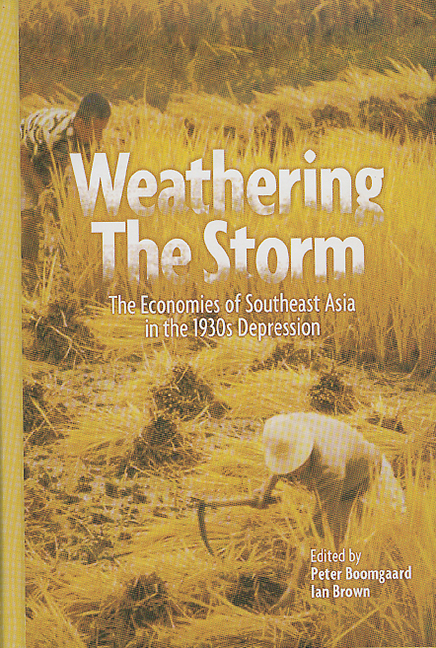Book contents
- Frontmatter
- Contents
- List of Tables
- List of Figures
- Acknowledgements
- List of Contributors
- 1 The Economies of Southeast Asia in the 1930s Depression: An Introduction
- PART I MATERIAL CONDITIONS
- PART II AGRICULTURAL STRATEGIES
- 6 Structural Origins of the Economic Depression in Indonesia During the 1930s
- 7 Entrepreneurial Strategies in Indigenous Export Agriculture in the Outer Islands of Colonial Indonesia, 1925-38
- 8 The Economy of Besuki in the 1930s Depression
- 9 The Rice Economy of Thailand in the 1930s Depression
- 10 Rice and the Colonial Lobby: The Economic Crisis in French Indo-China in the 1920s and 1930s
- PART III TRADING COMMUNITIES
- PART IV THE STATE'S RESPONSE
- Index
7 - Entrepreneurial Strategies in Indigenous Export Agriculture in the Outer Islands of Colonial Indonesia, 1925-38
from PART II - AGRICULTURAL STRATEGIES
Published online by Cambridge University Press: 21 October 2015
- Frontmatter
- Contents
- List of Tables
- List of Figures
- Acknowledgements
- List of Contributors
- 1 The Economies of Southeast Asia in the 1930s Depression: An Introduction
- PART I MATERIAL CONDITIONS
- PART II AGRICULTURAL STRATEGIES
- 6 Structural Origins of the Economic Depression in Indonesia During the 1930s
- 7 Entrepreneurial Strategies in Indigenous Export Agriculture in the Outer Islands of Colonial Indonesia, 1925-38
- 8 The Economy of Besuki in the 1930s Depression
- 9 The Rice Economy of Thailand in the 1930s Depression
- 10 Rice and the Colonial Lobby: The Economic Crisis in French Indo-China in the 1920s and 1930s
- PART III TRADING COMMUNITIES
- PART IV THE STATE'S RESPONSE
- Index
Summary
INTRODUCTION
In colonial Indonesia, as in several surrounding countries such as Malaysia and Thailand, the period 1914-42 was characterized by a large expansion in agricultural exports. In particular, the islands outside Java, the Outer Islands, gained economic significance in the colony by supplying large volumes of export products for the world market. An important share of these exports, up to an estimated 45 per cent or more of total agricultural exports, originated from indigenous peasants. These smallholders cultivated rubber, copra, coffee, pepper, and a number of other crops. Also they collected forest products such as rattan, damar, and copal, which they sold to earn a supplementary money income. This development of cash crop exports by smallholders, who gradually discarded (part of) their subsistence agriculture and became increasingly dependent on rice imports paid for in cash, has been described by, for example, Myint. The development of Indonesian agriculture and the coexistence of smallholders and European agricultural estates have been studied recently by a number of scholars.
This chapter studies the entrepreneurial strategies of Indonesian smallholders in the Outer Islands, focusing on the period during which the prices on the world market deteriorated severely due to the world depression. The focus is explicitly on the indigenous entrepreneur. European or American agricultural estates, as well as the oil and tin companies (concentrated in the provinces of East Sumatra, Palembang, Bangka, Belitung, and Southeast Kalimantan), are not dealt with in this chapter. It can be argued that Western enterprises, although perhaps beneficial to the national economy, had only limited growth effects on the regional economies and, more or less, formed economic enclaves. This indicates that the economy was essentially dualist and that a separate analysis of the indigenous economy is justified.
When the depression set in, in 1929, most prices of raw materials on the world market had already been falling for several years, for some commodities from 1925.
- Type
- Chapter
- Information
- Weathering the StormThe Economies of Southeast Asia in the 1930s Depression, pp. 143 - 170Publisher: ISEAS–Yusof Ishak InstitutePrint publication year: 2001

